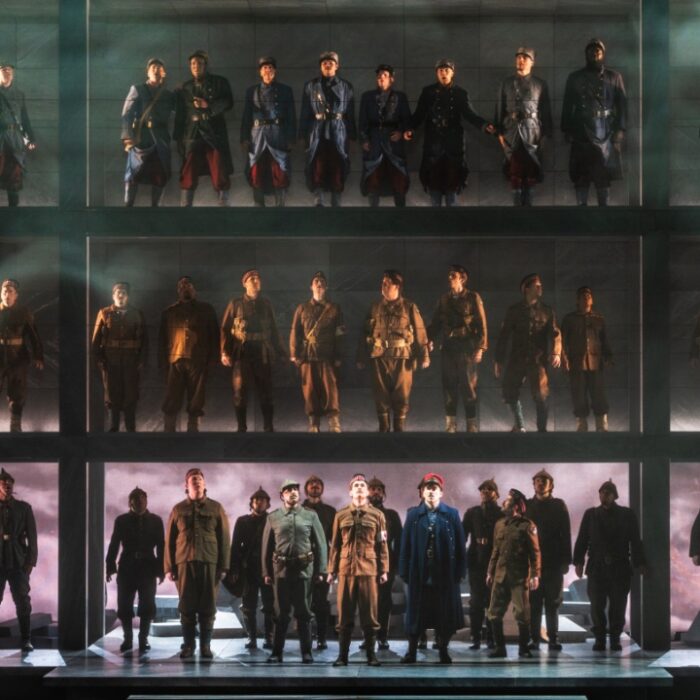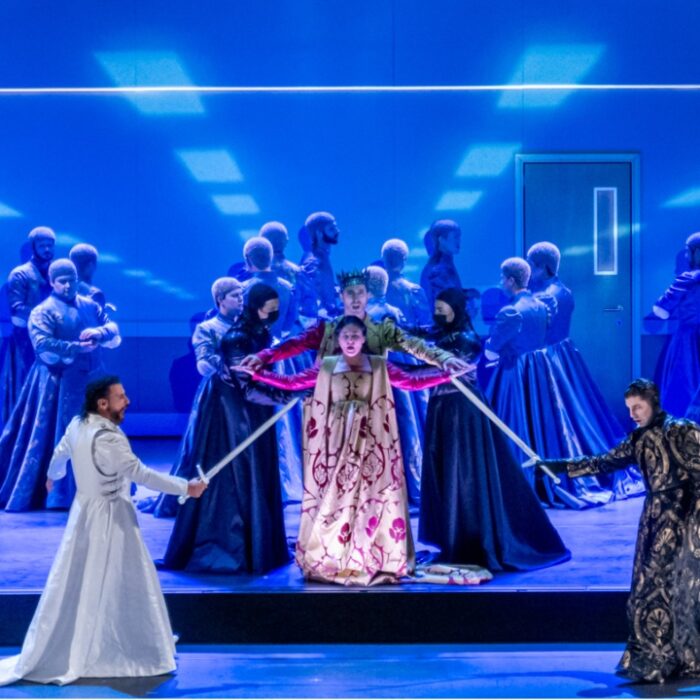
Festival d’Aix-en-Provence 2024 Review: Pelléas et Mélisande
Katie Mitchell’s Production Was All a Dream
By João Marcos Copertino(Photo credit: Jean-Louis Fernandez)
Eight years ago, Katie Mitchell’s staging of “Pelléas et Mélisande” was opera-lovers’ favorite summer topic. Echoes of its greatness could be heard in the wintery Brazilian July, and in the fall, when I was in Scotland, people still commented how great—or heterodox—it was. Its return to Aix’s stage reminds us of its scenic beauty and proves that, sometimes, an opera production can deploy the oldest tricks in the book and still look extremely fresh.
Dreams
There is no secret: in Mitchell’s production, it was all a dream. Mélisande, still in her wedding gown, rushes to take a pregnancy test. While waiting for its positive result, she falls asleep and has an uncanny but realistic dream. Her dreams are about entering a new family, her inner desires and fears, and most importantly, about herself and how she fears to be perceived. Her tale in the world of “Allemonde” is a tale of everyone (all people, instead of all the world). Her Mélisande suffers the misdeeds of entering a dysfunctionally decadent, wealthy, traditional family—a cautionary tale that shows the tragedy of heterosexuality.
College freshmen writers are often advised to not use the “it was all a dream” gimmick. There are many reasons why: it is cheap, cheesy, and lazy. The quick escape to unreality is mostly an excuse to not think things through in the process of writing. Mitchell circumvents such fragility by embracing precisely the oneiric nature of Debussy’s music and Maeterlinck’s drama. It is true that all operas are a bit dream-like, but only “Pelléas” is that truly ethereal—even when the conductors try to get more to the point.
This surreal “Pelléas” benefits from being one the most exuberant stagings of the century. Truly, in a time when the biggest national opera companies stage grand operas with just one scenario, Lizzie Clachan’s scenarios stand tall as relics from the “fatfleshed kine” years. We are presented with an infinitude of rooms, each one more exuberant than the last, and without ever being able to tell where the action will take us. What once was a bathroom is transfigured into a Hitchcockian set of stairs or an abandoned swimming pool.
This dreamish—or nightmarish—conception of “Pelléas” enabled Mitchell to address the ethereality of “Pelléas.” Even in the best conductor’s hands, the opera has an ethereality that overflows the drama. There is a certain aloofness in the characters’ dialogue, and it is sometimes even uncertain whether the characters have heard one other—or even the orchestral sounds. The dream approach allows things to be simultaneously heard and unheard, emulating the eerie experience of a surreal dialogue. At the same time, Mitchell gestures towards some resolutions for many enigmatic moments in “Pelléas”—from using the Royal family as the homeless elders in the caves, for example, to enacting a sexual encounter—or the dream desire of a sexual encounter—in the fourth-act climax. All these bold choices do not run contrary to the drama, but rather serve to exalt the symbolism in place on the stage.
Last, but not least, Mitchell’s main political commitment, which was to uncover the patriarchal logic within the operatic plot, worked smoothly with the musical drama. Mélisande is played as a woman who contemplates the possibility of being martyred by her possessive—and much older—husband. However, Golaud’s violence expands to include his daughter (Yniold in this production is a teenaged Avril Lavigne girl) and even his mother.
Musical Delight
Like a magic trick, Debussy’s music has never sounded better than it did at the end of the opera when Mélisande finally wakes up from her dream: the harps, the scenario with daylight, it all conspired for beauty.
It is hard to imagine a “Pelléas et Mélisande” in better orchestral hands than Susanna Mälkki’s. The Finnish conductor has established herself as a Debussy specialist, and in this “Pelléas” one can hear why. Although mostly respecting the singers’ voices, Mälkki’s approach is to put the orchestra first—not only in the manner of sonority, but also in terms of narration. While the vocal elements of the opera are fugitive (once uttered, they are gone), the orchestral mass carries elements of continuity throughout the drama, insisting on an almost physical mode of seeing the drama. The most erotic scenes (at the end of both the third and fourth acts) sounded visceral, sexual—while Golaud’s outbursts were indistinguishably and patriarchally violent (there is no tear of sympathy to be shed for him).
At the center of Mitchell and Mälkki’s project lay the work of Chiara Skerath as Mélisande. The Swiss soprano embodied a shy and mostly helpless Mélisande trying to navigate a universe perpetually outside her control. Almost always dazzled by her Doppelgänger’s actions, she wanders the stage as in a dream. Her helplessness even makes her erotic movements towards Pelléas seem overtly choreographed, as if she had the desire, but no control over how to perform it.
Her voice, with a tight vibrato—as is often the case with Mozartian singers nowadays—, carried a sense of delicacy and confusion that permeated throughout the night. Moreover, she knew quite well when to be acute in her vocal projection—hers was a Mélisande that placed the text first.
Huw Montague Rendall sang an equally eerie and passive Pelléas. Shy, walking on the stage as a frightened schoolboy, he was the representation of a mode of masculinity that is repressed by strong patriarchal figures. Given the fact he is a baritone, his voice showed a very edgy and dramatic tone in the upper range, contrasting with the actor’s movements, usually filled with a certain gnawer-like dazzlement. It worked best in the most climatic scenes, where one finds Debussy’s higher notes.
Certainly, the contemporary singer most acquainted with the role of Golaud is Laurent Naouri—so seeing him singing Debussy is always a pleasure. More often than not, I have been pleased to see Naouri singing smaller roles than his stardom leads one to expect—even though it is always nice to watch him, his acting skills are more nuanced and compelling when he is given the time to explore a character’s psychology on stage. His Golaud was all oppressive; still, what a compelling and anguished depiction of oppression! His agony at the end of the third act was unforgettable. In this oneiric conception of the drama, the main problem lies precisely in how real Golaud’s agony and threats appear to be.
Emma Fekete did extremely well composing the role of the here-petite Yniold who, even though rebellious, still suffers from domestic insalubrity. She showed a kinship with Mélisande that even increased the confusion on stage: what family is actually depicted here? If it is already hard to understand the relationship between Pelléas, Golaud, and Geneviève, in Mitchell’s version, the family’s ties of affection seemed to work in generational terms, with the young composing a better family than the elders.
Vincent Le Texier sings a perhaps less congenial Arkel—though he was still not oppressive as the grandson. Lucile Richardot is a well-composed Geneviève, who thankfully stayed on the stage to witness everything that happened in the later acts without uttering a word.
After almost a decade, it is hard to not be extremely impressed by Mitchell’s “Pelléas et Mélisande”: it is a visual and dramatic gem that provides a level of dramatic elaboration unmatched in the current, post-pandemic, austere decade. If I could, I would watch this production a few more times—a testament to how good it is, and also how much I like “Pelléas et Mélisande”—, but I cannot. Good dreams always end too soon.


